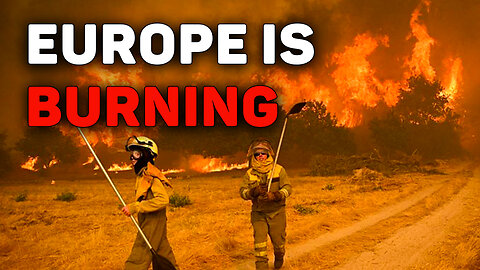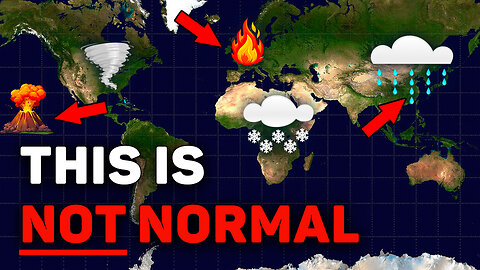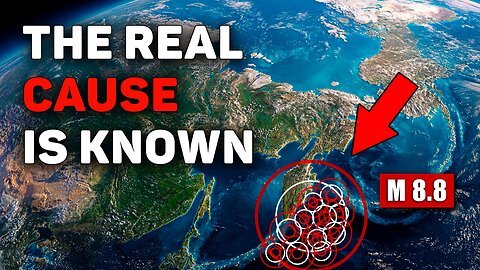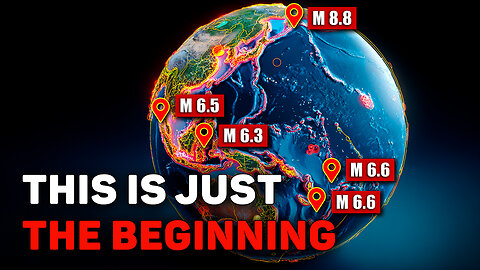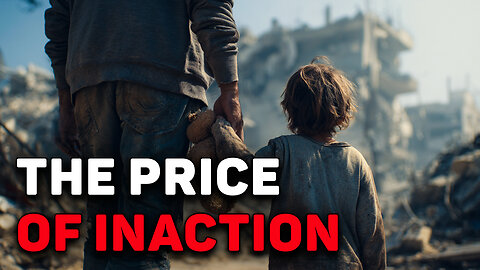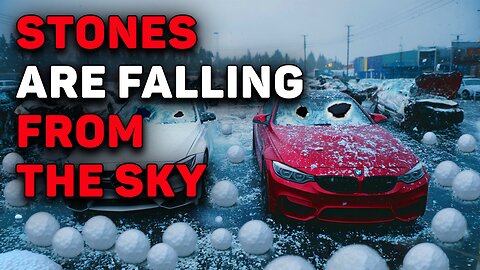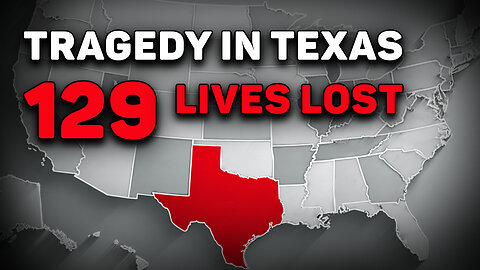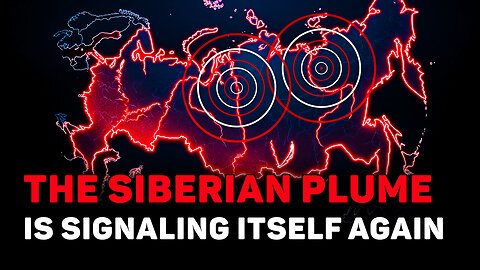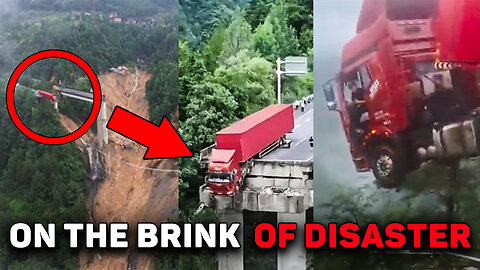
-
Why Do We No Longer See the Danger? One Week of Climate Reality
 Creative Society🌍 Italy under water. Brazil under ice. Poland struck by rare waterspouts. The Arctic smashing heat records, while Kamchatka is shaken by thousands of aftershocks. All of this happened in just one week. Each of these disasters could have been the headline of the year — yet today, we barely stop to notice. We just scroll past. We’ve started to treat climate collapse as background noise. But when records are broken every year and the “unbelievable” becomes seasonal routine — that’s not adaptation. That’s getting used to a crisis. This episode is about why it is critical — right now, today — to face where we are heading. Climate is not just for “scientists” or “environmentalists.” It’s about the air we breathe, the water we drink, and the land we live on. If we find the courage to face the truth, we can slow down the progression of climate change — and save lives. 📌 More videos on the real causes of escalating disasters and their progression based on a mathematical model: * Catastrophic Earthquakes Are Inevitable. Scientists’ Warning: 👉 https://youtu.be/Af0gKjSmlwI * This is inevitable! A scientific report opened the world’s eyes to climate truth: 👉 https://youtu.be/PAFdsPFwz8Q 🔔 Share this video with those who still think “the weather is just acting strange.” Every view is a step toward awareness. Knowledge saves lives — don’t let the truth stay hidden. ⏱️ Time code: 00:00 — Intro: Climate out of control 01:15 — Italy: storm destroys resorts 03:02 — Romania: deadly storm, roof collapse 04:30 — Guinea: landslide kills 16, whole family lost 06:10 — Russia: Arctic temperature record (+11.6°C) 07:45 — Yakutia, Taimyr, Dikson, Norilsk — the heat spreads 09:20 — Yemen: floods, epidemics, 14 dead 10:50 — Brazil: floods & hailstorm in Castro 13:00 — Typhoon “Kajiki”: China → Vietnam → Thailand 14:40 — Waterspouts: 20+ funnels over the Baltic Sea 16:00 — Earthquakes: M7.5 Drake Passage, M5.7 Caspian Sea 17:30 — Kamchatka: 12,000 aftershocks after M8.8 18:50 — Key point: “frog syndrome” & false normality 21:00 — Why we stop seeing catastrophe 22:30 — Conclusion: climate is changing faster than we realize200 views 1 comment
Creative Society🌍 Italy under water. Brazil under ice. Poland struck by rare waterspouts. The Arctic smashing heat records, while Kamchatka is shaken by thousands of aftershocks. All of this happened in just one week. Each of these disasters could have been the headline of the year — yet today, we barely stop to notice. We just scroll past. We’ve started to treat climate collapse as background noise. But when records are broken every year and the “unbelievable” becomes seasonal routine — that’s not adaptation. That’s getting used to a crisis. This episode is about why it is critical — right now, today — to face where we are heading. Climate is not just for “scientists” or “environmentalists.” It’s about the air we breathe, the water we drink, and the land we live on. If we find the courage to face the truth, we can slow down the progression of climate change — and save lives. 📌 More videos on the real causes of escalating disasters and their progression based on a mathematical model: * Catastrophic Earthquakes Are Inevitable. Scientists’ Warning: 👉 https://youtu.be/Af0gKjSmlwI * This is inevitable! A scientific report opened the world’s eyes to climate truth: 👉 https://youtu.be/PAFdsPFwz8Q 🔔 Share this video with those who still think “the weather is just acting strange.” Every view is a step toward awareness. Knowledge saves lives — don’t let the truth stay hidden. ⏱️ Time code: 00:00 — Intro: Climate out of control 01:15 — Italy: storm destroys resorts 03:02 — Romania: deadly storm, roof collapse 04:30 — Guinea: landslide kills 16, whole family lost 06:10 — Russia: Arctic temperature record (+11.6°C) 07:45 — Yakutia, Taimyr, Dikson, Norilsk — the heat spreads 09:20 — Yemen: floods, epidemics, 14 dead 10:50 — Brazil: floods & hailstorm in Castro 13:00 — Typhoon “Kajiki”: China → Vietnam → Thailand 14:40 — Waterspouts: 20+ funnels over the Baltic Sea 16:00 — Earthquakes: M7.5 Drake Passage, M5.7 Caspian Sea 17:30 — Kamchatka: 12,000 aftershocks after M8.8 18:50 — Key point: “frog syndrome” & false normality 21:00 — Why we stop seeing catastrophe 22:30 — Conclusion: climate is changing faster than we realize200 views 1 comment -
How Are We Getting Used To Climate Disasters? The Shifting Baseline Effect
 Creative SocietyImagine watching a river’s water level rise rapidly. In the first year, it surges 5 meters above normal — shocking. In the second year, 6 meters. In the third, 7. Each time you think: “This is incredible, this is a disaster!” But by the fifth year, when it rises 9 meters, you already say: “Well, compared to the previous years, that’s normal.” This is exactly how the climate shifting baseline effect works — one of the most insidious mechanisms that gradually changes our perception of what is “normal.” Between August 13 and 19, 2025, our planet endured numerous extreme climate events that together reveal a disturbing trend: we are living in an era where anomalies are becoming the new normal. In Pakistan, monsoon rains killed 358 people, destroying villages and leaving tens of thousands homeless. In Indonesia, a magnitude 5.8 earthquake destroyed 66 buildings, including a church during a service. Hurricane Erin strengthened from a tropical storm to a Category 5 monster in just 25 hours — an unprecedented pace. Even more unusual, such a powerful hurricane appeared in August, whereas the peak season is normally in September. But the most alarming thing is not the events themselves — it is how they are represented in the data. Scientists call this the “shifting window effect”: statistical baseline periods are constantly updated to include the most extreme recent years. For example: As of August 19, 2025, wildfire damage in the EU reached 1,015,024 hectares. Compared with the 2006–2015 average (256,702 ha), that’s nearly 4 times higher. But if we use the updated 2006–2024 baseline (354,628 ha), the deviation drops to 2.9 times. This approach creates the illusion of stability when, in reality, the system has already broken away from the old norms. It’s like measuring a patient’s temperature, but shifting the thermometer scale every day so that yesterday’s fever becomes “normal.” By the end of the week, 40°C may look like “just slightly above average.” That is how statistical smoothing hides the true scale of climate disasters. So when the media say, “Wildfires are only slightly worse than average,” it doesn’t mean the situation is under control. It means the “average” already includes catastrophic figures from recent years. What is dangerous is not only the catastrophic escalation of natural disasters but also the way we perceive them — or rather, fail to perceive them. 📌 On our channel, watch more materials about the real causes of intensifying climate disasters and their progression based on mathematical models: 👉 "Catastrophic Earthquakes Are Inevitable. Scientists’ Warning": https://youtu.be/Af0gKjSmlwI It’s Inevitable! A scientific report opened the world’s eyes to the truth about climate: 👉 "New Climate Report. Scientists Urgently Call for Humanity's Assistance": https://youtu.be/PAFdsPFwz8Q 👉 Share this video with those who still think that “the weather just got weird.” Every view is a step toward more people seeing reality. Knowledge saves lives — don’t let the truth remain behind the scenes. Time code: 00:00 — Introduction: the hidden reality of climate disasters 00:40 — Floods in India and Pakistan: destroyed villages and hundreds of victims 03:07 — Earthquake in Indonesia (M5.8): destruction and panic 04:16 — Hurricane Erin: from tropical storm to Category 5 monster 05:48 — Russia: record-breaking temperatures in the Arctic and Siberia 07:01 — Mexico: ice storm and a paralyzed city 08:23 — Australia: the strongest earthquake in 50 years 09:15 — Typhoon Podul: landfall on Taiwan and China 11:12 — Spain and Portugal: the largest wildfires in decades 13:28 — Why “average figures” hide the true scale of disasters #Climate2025 #ClimateCrisis #NaturalDisasters #GlobalWarming #PakistanFloods #IndonesiaEarthquake #HurricaneErin2025 #TyphoonPodul2025 #SpainWildfires #PortugalWildfires #AustraliaEarthquake #TaiwanTyphoon #ClimateData #Disasters2025 #TruthAboutClimate369 views 1 comment
Creative SocietyImagine watching a river’s water level rise rapidly. In the first year, it surges 5 meters above normal — shocking. In the second year, 6 meters. In the third, 7. Each time you think: “This is incredible, this is a disaster!” But by the fifth year, when it rises 9 meters, you already say: “Well, compared to the previous years, that’s normal.” This is exactly how the climate shifting baseline effect works — one of the most insidious mechanisms that gradually changes our perception of what is “normal.” Between August 13 and 19, 2025, our planet endured numerous extreme climate events that together reveal a disturbing trend: we are living in an era where anomalies are becoming the new normal. In Pakistan, monsoon rains killed 358 people, destroying villages and leaving tens of thousands homeless. In Indonesia, a magnitude 5.8 earthquake destroyed 66 buildings, including a church during a service. Hurricane Erin strengthened from a tropical storm to a Category 5 monster in just 25 hours — an unprecedented pace. Even more unusual, such a powerful hurricane appeared in August, whereas the peak season is normally in September. But the most alarming thing is not the events themselves — it is how they are represented in the data. Scientists call this the “shifting window effect”: statistical baseline periods are constantly updated to include the most extreme recent years. For example: As of August 19, 2025, wildfire damage in the EU reached 1,015,024 hectares. Compared with the 2006–2015 average (256,702 ha), that’s nearly 4 times higher. But if we use the updated 2006–2024 baseline (354,628 ha), the deviation drops to 2.9 times. This approach creates the illusion of stability when, in reality, the system has already broken away from the old norms. It’s like measuring a patient’s temperature, but shifting the thermometer scale every day so that yesterday’s fever becomes “normal.” By the end of the week, 40°C may look like “just slightly above average.” That is how statistical smoothing hides the true scale of climate disasters. So when the media say, “Wildfires are only slightly worse than average,” it doesn’t mean the situation is under control. It means the “average” already includes catastrophic figures from recent years. What is dangerous is not only the catastrophic escalation of natural disasters but also the way we perceive them — or rather, fail to perceive them. 📌 On our channel, watch more materials about the real causes of intensifying climate disasters and their progression based on mathematical models: 👉 "Catastrophic Earthquakes Are Inevitable. Scientists’ Warning": https://youtu.be/Af0gKjSmlwI It’s Inevitable! A scientific report opened the world’s eyes to the truth about climate: 👉 "New Climate Report. Scientists Urgently Call for Humanity's Assistance": https://youtu.be/PAFdsPFwz8Q 👉 Share this video with those who still think that “the weather just got weird.” Every view is a step toward more people seeing reality. Knowledge saves lives — don’t let the truth remain behind the scenes. Time code: 00:00 — Introduction: the hidden reality of climate disasters 00:40 — Floods in India and Pakistan: destroyed villages and hundreds of victims 03:07 — Earthquake in Indonesia (M5.8): destruction and panic 04:16 — Hurricane Erin: from tropical storm to Category 5 monster 05:48 — Russia: record-breaking temperatures in the Arctic and Siberia 07:01 — Mexico: ice storm and a paralyzed city 08:23 — Australia: the strongest earthquake in 50 years 09:15 — Typhoon Podul: landfall on Taiwan and China 11:12 — Spain and Portugal: the largest wildfires in decades 13:28 — Why “average figures” hide the true scale of disasters #Climate2025 #ClimateCrisis #NaturalDisasters #GlobalWarming #PakistanFloods #IndonesiaEarthquake #HurricaneErin2025 #TyphoonPodul2025 #SpainWildfires #PortugalWildfires #AustraliaEarthquake #TaiwanTyphoon #ClimateData #Disasters2025 #TruthAboutClimate369 views 1 comment -
From Kamchatka to Europe: A Week of Extreme Events | August 2025
 Creative SocietyCataclysms on the planet in 2025 are no longer forecasts, but real events affecting millions of people. This episode features a roundup of the most significant climate events from the past week, August 6–12, 2025: a mega-earthquake in Kamchatka (M8.8), increased volcanic activity across various regions, record-breaking floods, anomalous hail and snow in unexpected areas, as well as major wildfires and landslides in Europe and Asia. The episode emphasizes the connection between geodynamic processes (including the scientifically debated Siberian mantle plume), climate change, and the growing frequency of extreme weather events. This is more than just a chronicle — the goal of the video is to show cause-and-effect relationships and outline steps that can help reduce risks. We’re not spreading panic — just stating the facts. If you value verified data and a pragmatic analysis, watch the full episode. Share it with colleagues, emergency management specialists, and local authorities. Understanding the patterns of cataclysms on the planet in 2025 is the first step toward preparedness — and preparedness saves lives. #Cataclysms2025 #KamchatkaEarthquake #SiberianPlume365 views 3 comments
Creative SocietyCataclysms on the planet in 2025 are no longer forecasts, but real events affecting millions of people. This episode features a roundup of the most significant climate events from the past week, August 6–12, 2025: a mega-earthquake in Kamchatka (M8.8), increased volcanic activity across various regions, record-breaking floods, anomalous hail and snow in unexpected areas, as well as major wildfires and landslides in Europe and Asia. The episode emphasizes the connection between geodynamic processes (including the scientifically debated Siberian mantle plume), climate change, and the growing frequency of extreme weather events. This is more than just a chronicle — the goal of the video is to show cause-and-effect relationships and outline steps that can help reduce risks. We’re not spreading panic — just stating the facts. If you value verified data and a pragmatic analysis, watch the full episode. Share it with colleagues, emergency management specialists, and local authorities. Understanding the patterns of cataclysms on the planet in 2025 is the first step toward preparedness — and preparedness saves lives. #Cataclysms2025 #KamchatkaEarthquake #SiberianPlume365 views 3 comments -
Why Did Kamchatka Tremble, And What Does It Mean For The Whole World?
 Creative SocietyFrom July 30 to August 5, 2025, Earth witnessed a series of destructive disasters, showing that we are living in an era of global change. In Indonesia, the Lewotobi Laki-Laki volcano erupted twice within a few hours, sending ash up to 18 km high. China experienced deadly floods in Beijing that claimed dozens of lives, Australia was hit by abnormal snowfalls and hail, and the UK faced the rare and powerful Storm “Floris.” Sandstorms in Peru paralyzed entire cities, while in Russia — from Karelia to the Krasnodar region — tornadoes, mudflows, and extreme downpours were recorded. Scientists from ALLATRA warn: all these are links in the same chain, caused by astronomical cyclicity. Right now, our planet is going through a period of large-scale natural disasters that occur every 12,000 years. The most alarming event of the week was the M8.8 mega-earthquake in Kamchatka — one of the strongest ever recorded. It caused the displacement of the peninsula, hundreds of powerful aftershocks, and the awakening of dormant volcanoes, including the Krasheninnikov volcano, which had been “silent” for more than 500 years. Here we are not simply seeing the manifestation of activity from the Pacific Ring of Fire, but the result of pressure created by a giant magma plume — a stream of molten material rising from the Earth’s interior under Siberia, with its epicenter near the city of Norilsk. This means the mechanism of this earthquake is different, and so will be the development of events. That is why the powerful Kamchatka earthquake is not the end — it is only the beginning. And the next disaster may strike where it is least expected. Meanwhile, representatives of the scientific community, especially in Russia, continue to deny the obvious and persuade the public that “everything is under control.” Their opinion is presented in the media as the only correct one, although it is often unsupported by serious analysis or verification from other scientific fields. Still, it is served to the public as the ultimate truth. Another widely repeated claim is that the M8.8 earthquake “released” the tectonic plates, and therefore no major seismic events should be expected in the coming years or even decades. If timely measures are not taken for planned degassing of the focus — namely, the Siberian magma plume — then in just five years, earthquakes comparable in magnitude to the Kamchatka one will occur around the world on a weekly basis. This episode is not just a chronicle of disasters. It is a signal to each of us: it is time to face the truth, stop ignoring the facts, and search for real solutions. 00:00 — The M8.8 Kamchatka Earthquake Shook the World 00:45 — Chain Reaction of Volcanoes: Kamchatka Giants Awaken 02:20 — Indonesia: Double Eruption of the Lewotobi Laki-Laki Volcano 03:55 — Flooding in Beijing: Deadly Consequences and Failures in the Warning System 05:40 — Australia: Hail, Snow, and Rare Storms 06:25 — United Kingdom: Storm “Floris” Cancels Historic Events 07:10 — Peru: Giant Sandstorm Turns Day into Night 08:35 — Russia: Landslides, Tornadoes, and Extreme Downpours 09:50 — The Truth About the Siberian Magma Plume 11:15 — Why Scientists Downplay the Real Danger 12:40 — Future Scenarios If No Action Is Taken489 views 3 comments
Creative SocietyFrom July 30 to August 5, 2025, Earth witnessed a series of destructive disasters, showing that we are living in an era of global change. In Indonesia, the Lewotobi Laki-Laki volcano erupted twice within a few hours, sending ash up to 18 km high. China experienced deadly floods in Beijing that claimed dozens of lives, Australia was hit by abnormal snowfalls and hail, and the UK faced the rare and powerful Storm “Floris.” Sandstorms in Peru paralyzed entire cities, while in Russia — from Karelia to the Krasnodar region — tornadoes, mudflows, and extreme downpours were recorded. Scientists from ALLATRA warn: all these are links in the same chain, caused by astronomical cyclicity. Right now, our planet is going through a period of large-scale natural disasters that occur every 12,000 years. The most alarming event of the week was the M8.8 mega-earthquake in Kamchatka — one of the strongest ever recorded. It caused the displacement of the peninsula, hundreds of powerful aftershocks, and the awakening of dormant volcanoes, including the Krasheninnikov volcano, which had been “silent” for more than 500 years. Here we are not simply seeing the manifestation of activity from the Pacific Ring of Fire, but the result of pressure created by a giant magma plume — a stream of molten material rising from the Earth’s interior under Siberia, with its epicenter near the city of Norilsk. This means the mechanism of this earthquake is different, and so will be the development of events. That is why the powerful Kamchatka earthquake is not the end — it is only the beginning. And the next disaster may strike where it is least expected. Meanwhile, representatives of the scientific community, especially in Russia, continue to deny the obvious and persuade the public that “everything is under control.” Their opinion is presented in the media as the only correct one, although it is often unsupported by serious analysis or verification from other scientific fields. Still, it is served to the public as the ultimate truth. Another widely repeated claim is that the M8.8 earthquake “released” the tectonic plates, and therefore no major seismic events should be expected in the coming years or even decades. If timely measures are not taken for planned degassing of the focus — namely, the Siberian magma plume — then in just five years, earthquakes comparable in magnitude to the Kamchatka one will occur around the world on a weekly basis. This episode is not just a chronicle of disasters. It is a signal to each of us: it is time to face the truth, stop ignoring the facts, and search for real solutions. 00:00 — The M8.8 Kamchatka Earthquake Shook the World 00:45 — Chain Reaction of Volcanoes: Kamchatka Giants Awaken 02:20 — Indonesia: Double Eruption of the Lewotobi Laki-Laki Volcano 03:55 — Flooding in Beijing: Deadly Consequences and Failures in the Warning System 05:40 — Australia: Hail, Snow, and Rare Storms 06:25 — United Kingdom: Storm “Floris” Cancels Historic Events 07:10 — Peru: Giant Sandstorm Turns Day into Night 08:35 — Russia: Landslides, Tornadoes, and Extreme Downpours 09:50 — The Truth About the Siberian Magma Plume 11:15 — Why Scientists Downplay the Real Danger 12:40 — Future Scenarios If No Action Is Taken489 views 3 comments -
Week of Disasters: Mega Earthquake M8.8, Tsunami, Fires, Storms
 Creative SocietyThe 2025 Kamchatka earthquake shook not only Russia’s Far East but the entire world. With a magnitude of 8.8, it stands among the most powerful earthquakes recorded in modern history. It triggered a tsunami, awakened the Klyuchevskoy volcano, and served as a stark reminder: the Siberian plume is sending alarming signals. What was once considered a scientific forecast is now becoming our reality. But Kamchatka is only the tip of the iceberg. While media attention was focused on the seismic shocks in the Far East, other equally concerning events were unfolding around the globe: – In Singapore, a massive sinkhole suddenly opened in the city center. – In the Philippines, Typhoon Kompasu forced the evacuation of hundreds of thousands. – In Kazakhstan and Russia, hurricane-force winds tore off roofs and downed power lines. – In Belarus and Germany, torrential rains caused flooding and landslides. – Southern Europe was burning once again — Türkiye, Greece, Italy, and Portugal battled large-scale wildfires. All these events are links in the same chain. We are witnessing increasing seismic activity, extreme storms, floods, and fires — yet we continue to ignore the obvious. Now, more than ever, it is crucial to track the facts, monitor trends, and search for real solutions. Otherwise, the next shock might catch every one of us off guard. Timecode: 00:00 — Introduction: Kamchatka and global resonance 01:15 — M8.8 earthquake and tsunami, Siberian plume 04:05 — Klyuchevskoy volcano awakening 04:21 — Singapore: giant sinkhole in the city center 04:52 — Philippines: Typhoon Kompasu 05:44 — Kazakhstan: storm in Astana 06:18 — Russia: storm in Volgograd region 07:13 — Belarus: flood and landslide in Vitebsk 07:59 — Germany: storms and train derailment 09:05 — Europe: heatwaves and wildfires (Türkiye, Greece, Italy, Portugal) 13:42 — Conclusion: ignoring the facts vs. finding solutions 📍 Catastrophic earthquakes are inevitable for humanity — Egon Cholakian 📍 It’s inevitable! A scientific report opened the world’s eyes to the truth about the climate695 views 5 comments
Creative SocietyThe 2025 Kamchatka earthquake shook not only Russia’s Far East but the entire world. With a magnitude of 8.8, it stands among the most powerful earthquakes recorded in modern history. It triggered a tsunami, awakened the Klyuchevskoy volcano, and served as a stark reminder: the Siberian plume is sending alarming signals. What was once considered a scientific forecast is now becoming our reality. But Kamchatka is only the tip of the iceberg. While media attention was focused on the seismic shocks in the Far East, other equally concerning events were unfolding around the globe: – In Singapore, a massive sinkhole suddenly opened in the city center. – In the Philippines, Typhoon Kompasu forced the evacuation of hundreds of thousands. – In Kazakhstan and Russia, hurricane-force winds tore off roofs and downed power lines. – In Belarus and Germany, torrential rains caused flooding and landslides. – Southern Europe was burning once again — Türkiye, Greece, Italy, and Portugal battled large-scale wildfires. All these events are links in the same chain. We are witnessing increasing seismic activity, extreme storms, floods, and fires — yet we continue to ignore the obvious. Now, more than ever, it is crucial to track the facts, monitor trends, and search for real solutions. Otherwise, the next shock might catch every one of us off guard. Timecode: 00:00 — Introduction: Kamchatka and global resonance 01:15 — M8.8 earthquake and tsunami, Siberian plume 04:05 — Klyuchevskoy volcano awakening 04:21 — Singapore: giant sinkhole in the city center 04:52 — Philippines: Typhoon Kompasu 05:44 — Kazakhstan: storm in Astana 06:18 — Russia: storm in Volgograd region 07:13 — Belarus: flood and landslide in Vitebsk 07:59 — Germany: storms and train derailment 09:05 — Europe: heatwaves and wildfires (Türkiye, Greece, Italy, Portugal) 13:42 — Conclusion: ignoring the facts vs. finding solutions 📍 Catastrophic earthquakes are inevitable for humanity — Egon Cholakian 📍 It’s inevitable! A scientific report opened the world’s eyes to the truth about the climate695 views 5 comments -
Disasters Monitoring: The Truth Parents Don't See
 Creative SocietyCataclysms on the planet in 2025 go beyond weather anomalies — they are destroying lives and the future. Especially the future of our children. This video presents a summary of climate events from July 16 to 22, 2025, which claimed dozens of lives and left millions in disaster zones. In focus: powerful downpours in South Korea, fierce typhoons in the Pacific region, increased seismic activity across the planet, and devastating natural disasters in Russia, the U.S., and Europe. These processes are already affecting the lives of millions — not somewhere far away, but here and now. 🔍 In addition to the event chronology, this episode raises a critical question: What does caring for the future actually mean in practice? What steps can we take today to create more sustainable living conditions? 💬 This video is not just a disaster roundup. It's a challenge to indifference. A reminder that the future is not an abstract idea — it's a reality we are all responsible for. 📌 Watch, share, join the conversation. We can change the course — but only together. Timecode: 00:00 — Introduction: Our children’s future — what are we missing as parents in the era of rising cataclysms? 00:30 — Pakistan: 63 dead, destroyed roads and dams 01:45 — Vietnam: tragedy in Halong Bay, capsized vessel 02:58 — Romania: storm in Wallachia, fatalities in Bucharest 03:50 — USA: flash flooding in Montgomery County and lightning strike 05:20 — Russia: deadly lightning in Karachay-Cherkessia and Tuva 05:58 — Kamchatka: series of strong earthquakes up to M7.6 08:03 — Alaska and Naples: underground activity, tunnel closure 08:51 — Typhoon Wipha: destruction in China, Vietnam, and the Philippines 10:41 — South Korea: record-breaking rains and mass evacuations 12:11 — Final message: what does it mean to be a parent in the age of disasters?452 views 1 comment
Creative SocietyCataclysms on the planet in 2025 go beyond weather anomalies — they are destroying lives and the future. Especially the future of our children. This video presents a summary of climate events from July 16 to 22, 2025, which claimed dozens of lives and left millions in disaster zones. In focus: powerful downpours in South Korea, fierce typhoons in the Pacific region, increased seismic activity across the planet, and devastating natural disasters in Russia, the U.S., and Europe. These processes are already affecting the lives of millions — not somewhere far away, but here and now. 🔍 In addition to the event chronology, this episode raises a critical question: What does caring for the future actually mean in practice? What steps can we take today to create more sustainable living conditions? 💬 This video is not just a disaster roundup. It's a challenge to indifference. A reminder that the future is not an abstract idea — it's a reality we are all responsible for. 📌 Watch, share, join the conversation. We can change the course — but only together. Timecode: 00:00 — Introduction: Our children’s future — what are we missing as parents in the era of rising cataclysms? 00:30 — Pakistan: 63 dead, destroyed roads and dams 01:45 — Vietnam: tragedy in Halong Bay, capsized vessel 02:58 — Romania: storm in Wallachia, fatalities in Bucharest 03:50 — USA: flash flooding in Montgomery County and lightning strike 05:20 — Russia: deadly lightning in Karachay-Cherkessia and Tuva 05:58 — Kamchatka: series of strong earthquakes up to M7.6 08:03 — Alaska and Naples: underground activity, tunnel closure 08:51 — Typhoon Wipha: destruction in China, Vietnam, and the Philippines 10:41 — South Korea: record-breaking rains and mass evacuations 12:11 — Final message: what does it mean to be a parent in the age of disasters?452 views 1 comment -
Giant Hail: The Result of Humanity’s Fatal Mistake
 Creative SocietyCataclysms on the planet in 2025 are no longer the exception — they are becoming the new frightening reality. In this video, we show how, in just one week — from July 9 to 17 — the planet experienced a wave of destructive climate anomalies. From Spain to India, from Latvia to El Salvador, the world is facing unprecedented weather phenomena: hail the size of a ball, tornadoes in Eastern Europe, hydrothermal explosions, and record-breaking downpours paralyzing major cities. These events are not isolated. They are part of a single, intensifying process of climate instability. We are increasingly witnessing hailstorms destroying crops, lightning strikes igniting fires, and rainfalls of extreme intensity. And this is not just nature’s whim. Scientists point to a new climatically active factor: micro- and nanoplastics — now acting as a catalyst in many atmospheric processes. They alter precipitation formation and provoke extreme weather events. 📌 In this episode: Weekly disaster roundup Why hail is becoming more frequent and more destructive How plastic has become a climatically active substance Why the world now faces a threat it created itself ❗ If we don’t act, we’re not just facing disasters — but the collapse of the entire climate system. ⏱ Timestamps: 00:00 — Introduction: scale of cataclysms on the planet in 2025 01:10 — Romania: intense summer hail, sudden temperature drop 02:45 — Ukraine: record rainfall, tornadoes, and storms 06:55 — Spain: Cyclone DANA, floods, infrastructure destruction, 26,000 lightning strikes 11:40 — El Salvador: geyser explosion, possibly triggered by Guatemala earthquake 13:40 — India: bridge collapse, 20 dead 14:55 — Belarus: powerful storm, mass power outages, EF2 tornado in Vitebsk region 17:35 — Russia: squalls, hail, lightning-triggered fires in Pskov and Novgorod regions, floods in Moscow, storm fatalities in Samara region 22:00 — Latvia: giant 11.5 cm hailstones, national record 24:00 — Root cause: how plastic affects the climate 26:40 — What scientists discovered: atmosphere, health, conclusions 29:00 — Final thoughts: where this path leads — and whether we still have a chance842 views 3 comments
Creative SocietyCataclysms on the planet in 2025 are no longer the exception — they are becoming the new frightening reality. In this video, we show how, in just one week — from July 9 to 17 — the planet experienced a wave of destructive climate anomalies. From Spain to India, from Latvia to El Salvador, the world is facing unprecedented weather phenomena: hail the size of a ball, tornadoes in Eastern Europe, hydrothermal explosions, and record-breaking downpours paralyzing major cities. These events are not isolated. They are part of a single, intensifying process of climate instability. We are increasingly witnessing hailstorms destroying crops, lightning strikes igniting fires, and rainfalls of extreme intensity. And this is not just nature’s whim. Scientists point to a new climatically active factor: micro- and nanoplastics — now acting as a catalyst in many atmospheric processes. They alter precipitation formation and provoke extreme weather events. 📌 In this episode: Weekly disaster roundup Why hail is becoming more frequent and more destructive How plastic has become a climatically active substance Why the world now faces a threat it created itself ❗ If we don’t act, we’re not just facing disasters — but the collapse of the entire climate system. ⏱ Timestamps: 00:00 — Introduction: scale of cataclysms on the planet in 2025 01:10 — Romania: intense summer hail, sudden temperature drop 02:45 — Ukraine: record rainfall, tornadoes, and storms 06:55 — Spain: Cyclone DANA, floods, infrastructure destruction, 26,000 lightning strikes 11:40 — El Salvador: geyser explosion, possibly triggered by Guatemala earthquake 13:40 — India: bridge collapse, 20 dead 14:55 — Belarus: powerful storm, mass power outages, EF2 tornado in Vitebsk region 17:35 — Russia: squalls, hail, lightning-triggered fires in Pskov and Novgorod regions, floods in Moscow, storm fatalities in Samara region 22:00 — Latvia: giant 11.5 cm hailstones, national record 24:00 — Root cause: how plastic affects the climate 26:40 — What scientists discovered: atmosphere, health, conclusions 29:00 — Final thoughts: where this path leads — and whether we still have a chance842 views 3 comments -
Climate Emergency of the Week: Disasters Are Destroying Cities, but All Are Silent On the Essential
 Creative SocietyClimate Events Are Becoming More Extreme and Unpredictable. This past week, the U.S. faced a tragedy — a sudden and catastrophically powerful flood that caught both authorities and residents off guard. And this happened in a country equipped with advanced disaster forecasting systems, emergency alert infrastructure, and technical capabilities for rapid response. At the same time, a series of disasters struck around the globe, each one rare in the past — now becoming reality: floods, snow in July, volcanic activity, and deadly storms. These events are interconnected, driven by deepening geophysical and climatic instability. In truth, if we take an honest look at the climate situation, there is little reason for optimism. No signs of improvement are visible — on the contrary, the situation is clearly worsening. 📌 Key events of the week: – USA: A catastrophic flash flood in Texas claimed 129 lives, including 27 children. – Typhoon Danas: Historic devastation in Taiwan — the worst in 120 years. – Indonesia: The Lewotobi volcano erupted, sending ash clouds up to 18 km; mass evacuations followed. – Australia: A bomb cyclone brought waves up to 12 meters and extensive flooding. – Türkiye: Snowfall in July with record-breaking cold. – China: Landslides and mudflows in Sichuan destroyed vital infrastructure. – Russia: Torrential rains and hail in Siberia; severe flooding in Zabaykalsky Krai; widespread damage in Omsk, Tyumen, and Khabarovsk. 🧩 These events no longer fit the traditional category of "natural disasters." What we are witnessing is a fundamental transformation of the planet’s climate system, fueled by intensified geodynamic processes. And yet, despite the growing threats, most institutional responses remain passive — and this inertia is one of the most dangerous challenges we face. 🕒 Timecode: 00:00 — Introduction: Why forecasts are failing 01:15 — USA, Texas: Flash flood kills 129 people, including 27 children 04:45 — Taiwan: Typhoon Danas brings destruction and torrential rains 07:10 — China: Typhoon spreads inland, worsening impacts 08:00 — Indonesia: Lewotobi volcano erupts, evacuation begins 10:00 — Australia: Bomb cyclone causes floods, hurricane-force winds 12:00 — Türkiye: July snowfall and unusual cold snap 13:10 — China, Sichuan: Landslides and destruction, people missing 15:00 — Russia: Torrential rains in Tyumen, Omsk, Khabarovsk, Zabaykalsky Krai 19:00 — Conclusion: Why the system of disasters can no longer be ignored We are living in a time of global paradox: billions of people, immense scientific potential — and yet almost total inaction in the face of the climate threat. But as long as there are those who remain undaunted by indifference, who see, understand, and act — hope remains. This is not the time to give up. Alone, we can’t do it. But together, we still have a chance.888 views 3 comments
Creative SocietyClimate Events Are Becoming More Extreme and Unpredictable. This past week, the U.S. faced a tragedy — a sudden and catastrophically powerful flood that caught both authorities and residents off guard. And this happened in a country equipped with advanced disaster forecasting systems, emergency alert infrastructure, and technical capabilities for rapid response. At the same time, a series of disasters struck around the globe, each one rare in the past — now becoming reality: floods, snow in July, volcanic activity, and deadly storms. These events are interconnected, driven by deepening geophysical and climatic instability. In truth, if we take an honest look at the climate situation, there is little reason for optimism. No signs of improvement are visible — on the contrary, the situation is clearly worsening. 📌 Key events of the week: – USA: A catastrophic flash flood in Texas claimed 129 lives, including 27 children. – Typhoon Danas: Historic devastation in Taiwan — the worst in 120 years. – Indonesia: The Lewotobi volcano erupted, sending ash clouds up to 18 km; mass evacuations followed. – Australia: A bomb cyclone brought waves up to 12 meters and extensive flooding. – Türkiye: Snowfall in July with record-breaking cold. – China: Landslides and mudflows in Sichuan destroyed vital infrastructure. – Russia: Torrential rains and hail in Siberia; severe flooding in Zabaykalsky Krai; widespread damage in Omsk, Tyumen, and Khabarovsk. 🧩 These events no longer fit the traditional category of "natural disasters." What we are witnessing is a fundamental transformation of the planet’s climate system, fueled by intensified geodynamic processes. And yet, despite the growing threats, most institutional responses remain passive — and this inertia is one of the most dangerous challenges we face. 🕒 Timecode: 00:00 — Introduction: Why forecasts are failing 01:15 — USA, Texas: Flash flood kills 129 people, including 27 children 04:45 — Taiwan: Typhoon Danas brings destruction and torrential rains 07:10 — China: Typhoon spreads inland, worsening impacts 08:00 — Indonesia: Lewotobi volcano erupts, evacuation begins 10:00 — Australia: Bomb cyclone causes floods, hurricane-force winds 12:00 — Türkiye: July snowfall and unusual cold snap 13:10 — China, Sichuan: Landslides and destruction, people missing 15:00 — Russia: Torrential rains in Tyumen, Omsk, Khabarovsk, Zabaykalsky Krai 19:00 — Conclusion: Why the system of disasters can no longer be ignored We are living in a time of global paradox: billions of people, immense scientific potential — and yet almost total inaction in the face of the climate threat. But as long as there are those who remain undaunted by indifference, who see, understand, and act — hope remains. This is not the time to give up. Alone, we can’t do it. But together, we still have a chance.888 views 3 comments -
What Is Happening to the Earth? Escalating Disasters and a Threat from the Depths
 Creative SocietyWhat’s Happening to the Planet? We are witnessing extreme weather events more and more frequently: torrential rains, hail, heatwaves, floods, and wildfires. Just over the past week alone — a tornado in France, hail up to 10 cm in diameter in Italy, 46.6 °C in Portugal, snow in the Atacama Desert, catastrophic floods in China, a ground collapse and an unusual earthquake in Siberia, and deadly floods in Pakistan. But the most alarming threat lies hidden deep underground. The Siberian mantle plume is showing worrying signs of reactivation. It was this very plume that triggered a mass extinction 250 million years ago. And now, the signs are similar: abnormal temperature spikes, increased seismic activity, sinkholes, deep degassing of the Earth’s crust, and more. 💥 If a breakthrough occurs, nearly the entire surface of the planet could become uninhabitable. The media are silent. Authorities are silent. But we cannot remain silent. 🧠 In this video: — Europe on fire: heatwaves, wildfires, evacuations — France: devastating “derecho” storm, 2,500 rescue operations in one night — Pakistan: tourists swept away by flash floods — China: two massive floods in 4 days, 150,000 affected — Russia: sinkholes in Norilsk, unusual M5.1 earthquake in Yakutia ⚠️ One conclusion: disasters are intensifying, and they are interconnected. If nothing is done, we are heading toward a point of no return. Silence is not an option. There is a real solution — planned degassing. Controlled release of gases and lava from the Earth’s interior could not only eliminate the threat of a plume breakthrough but also reduce internal pressure in the Earth’s magmatic system. This would help prevent devastating earthquakes like those that claimed thousands of lives in Türkiye, Myanmar, and other countries — and could also help stabilize the planet’s climate. Only through united efforts can we save life on Earth. Spread the word — before it’s too late. Timecode: 00:00 — Introduction: An unusual week of disasters 00:35 — France: Derecho hurricane, destruction, casualties 02:07 — Italy: 10 cm hail, tens of thousands of lightning strikes 02:43 — Spain, Portugal: +46 °C heatwave 03:23 — Austria, Slovenia, Bosnia and Herzegovina: temperature records 03:55 — Germany: Rhine River drying up 04:55 — Greece and Türkiye: wildfires, evacuations 06:39 — Pakistan: tragedy on the Swat River 07:45 — Chile: snow in the Atacama Desert 08:39 — China: two floods in four days, 150,000 affected 09:53 — Russia: M5.1 earthquake in Yakutia, sinkhole in Norilsk 11:48 — Conclusion: What the media are silent about, and why action is urgent now751 views 2 comments
Creative SocietyWhat’s Happening to the Planet? We are witnessing extreme weather events more and more frequently: torrential rains, hail, heatwaves, floods, and wildfires. Just over the past week alone — a tornado in France, hail up to 10 cm in diameter in Italy, 46.6 °C in Portugal, snow in the Atacama Desert, catastrophic floods in China, a ground collapse and an unusual earthquake in Siberia, and deadly floods in Pakistan. But the most alarming threat lies hidden deep underground. The Siberian mantle plume is showing worrying signs of reactivation. It was this very plume that triggered a mass extinction 250 million years ago. And now, the signs are similar: abnormal temperature spikes, increased seismic activity, sinkholes, deep degassing of the Earth’s crust, and more. 💥 If a breakthrough occurs, nearly the entire surface of the planet could become uninhabitable. The media are silent. Authorities are silent. But we cannot remain silent. 🧠 In this video: — Europe on fire: heatwaves, wildfires, evacuations — France: devastating “derecho” storm, 2,500 rescue operations in one night — Pakistan: tourists swept away by flash floods — China: two massive floods in 4 days, 150,000 affected — Russia: sinkholes in Norilsk, unusual M5.1 earthquake in Yakutia ⚠️ One conclusion: disasters are intensifying, and they are interconnected. If nothing is done, we are heading toward a point of no return. Silence is not an option. There is a real solution — planned degassing. Controlled release of gases and lava from the Earth’s interior could not only eliminate the threat of a plume breakthrough but also reduce internal pressure in the Earth’s magmatic system. This would help prevent devastating earthquakes like those that claimed thousands of lives in Türkiye, Myanmar, and other countries — and could also help stabilize the planet’s climate. Only through united efforts can we save life on Earth. Spread the word — before it’s too late. Timecode: 00:00 — Introduction: An unusual week of disasters 00:35 — France: Derecho hurricane, destruction, casualties 02:07 — Italy: 10 cm hail, tens of thousands of lightning strikes 02:43 — Spain, Portugal: +46 °C heatwave 03:23 — Austria, Slovenia, Bosnia and Herzegovina: temperature records 03:55 — Germany: Rhine River drying up 04:55 — Greece and Türkiye: wildfires, evacuations 06:39 — Pakistan: tragedy on the Swat River 07:45 — Chile: snow in the Atacama Desert 08:39 — China: two floods in four days, 150,000 affected 09:53 — Russia: M5.1 earthquake in Yakutia, sinkhole in Norilsk 11:48 — Conclusion: What the media are silent about, and why action is urgent now751 views 2 comments -
New Threats: Familiar Scenarios No Longer Work
 Creative Society🔴 Cataclysms on the Planet Continue to Intensify in 2025. Each passing week brings new evidence: hurricanes, tornadoes, downpours, heatwaves, landslides, droughts — these are no longer exceptions, but are becoming the norm. We've entered an era of climate chaos, and the events from June 18 to 24, 2025, confirm it. 🌪 China — A landslide destroyed a bridge on the G76 highway; a truck was left hanging over the abyss. 🌬 Kazakhstan — Hurricane-force winds up to 43 m/s toppled cranes and bus stops. One woman died. 🌊 Mexico — Tropical hurricane *Erik* (Category 3) destroyed homes and claimed lives. ☔ Nepal — Raging monsoon-fueled waters swept away buses; excavators were used to rescue people. 🌧 India — Torrential rains, collapsed bridges, destroyed temples, dozens dead. 🔥 Russia — Record-breaking heat up to +39.8°C in Siberia and Transbaikalia. At the same time — frost in the central part of the country. 🌊 Brazil — Widespread flooding in Rio Grande do Sul: bridges destroyed, cities cut off. 🌪 USA — EF-3 tornado, heat up to +38°C, destruction, and fatalities. ⚠️ What is happening to the climate? Why do familiar weather patterns no longer work? Today, a typical rainstorm can turn into a flood, and calm weather can suddenly shift into a violent hurricane. People feel lost because they rely on past experiences — but those no longer apply. ✅ In this episode: — Weekly global cataclysm monitoring — Real destruction, casualties, and consequences — Tips on how to act during a natural disaster — Why preparedness is not panic, but rational planning 💡 We’re not here to scare — we show reality. When we’re prepared and know what to do, we act. It's crucial to understand: saving your life is your personal responsibility. That’s why it’s worth taking the time to learn how to evacuate properly and prepare a go-bag. This really matters. Life is the most valuable thing we have. ⏱️ Timecodes: 00:00 — Intro: why we ignore climate signals 01:12 — China: bridge destroyed by a landslide, miracle driver rescue 02:21 — Kazakhstan: powerful storm in Pavlodar, tragic outcome 03:45 — Mexico: tropical hurricane “Erik”, 205 km/h winds, flooded cities 05:17 — Nepal: bus swept away, emergency evacuation 06:31 — India: monsoon, destroyed temples and roads, casualties 08:15 — Russia: abnormal heat in Siberia, snow in Murmansk 10:12 — Brazil: Fandango Bridge underwater, ferry evacuations 11:49 — USA: EF-3 tornado, +38°C heat, deadly storms 13:00 — Conclusion: how to survive in chaos and why you need a plan934 views 7 comments
Creative Society🔴 Cataclysms on the Planet Continue to Intensify in 2025. Each passing week brings new evidence: hurricanes, tornadoes, downpours, heatwaves, landslides, droughts — these are no longer exceptions, but are becoming the norm. We've entered an era of climate chaos, and the events from June 18 to 24, 2025, confirm it. 🌪 China — A landslide destroyed a bridge on the G76 highway; a truck was left hanging over the abyss. 🌬 Kazakhstan — Hurricane-force winds up to 43 m/s toppled cranes and bus stops. One woman died. 🌊 Mexico — Tropical hurricane *Erik* (Category 3) destroyed homes and claimed lives. ☔ Nepal — Raging monsoon-fueled waters swept away buses; excavators were used to rescue people. 🌧 India — Torrential rains, collapsed bridges, destroyed temples, dozens dead. 🔥 Russia — Record-breaking heat up to +39.8°C in Siberia and Transbaikalia. At the same time — frost in the central part of the country. 🌊 Brazil — Widespread flooding in Rio Grande do Sul: bridges destroyed, cities cut off. 🌪 USA — EF-3 tornado, heat up to +38°C, destruction, and fatalities. ⚠️ What is happening to the climate? Why do familiar weather patterns no longer work? Today, a typical rainstorm can turn into a flood, and calm weather can suddenly shift into a violent hurricane. People feel lost because they rely on past experiences — but those no longer apply. ✅ In this episode: — Weekly global cataclysm monitoring — Real destruction, casualties, and consequences — Tips on how to act during a natural disaster — Why preparedness is not panic, but rational planning 💡 We’re not here to scare — we show reality. When we’re prepared and know what to do, we act. It's crucial to understand: saving your life is your personal responsibility. That’s why it’s worth taking the time to learn how to evacuate properly and prepare a go-bag. This really matters. Life is the most valuable thing we have. ⏱️ Timecodes: 00:00 — Intro: why we ignore climate signals 01:12 — China: bridge destroyed by a landslide, miracle driver rescue 02:21 — Kazakhstan: powerful storm in Pavlodar, tragic outcome 03:45 — Mexico: tropical hurricane “Erik”, 205 km/h winds, flooded cities 05:17 — Nepal: bus swept away, emergency evacuation 06:31 — India: monsoon, destroyed temples and roads, casualties 08:15 — Russia: abnormal heat in Siberia, snow in Murmansk 10:12 — Brazil: Fandango Bridge underwater, ferry evacuations 11:49 — USA: EF-3 tornado, +38°C heat, deadly storms 13:00 — Conclusion: how to survive in chaos and why you need a plan934 views 7 comments
